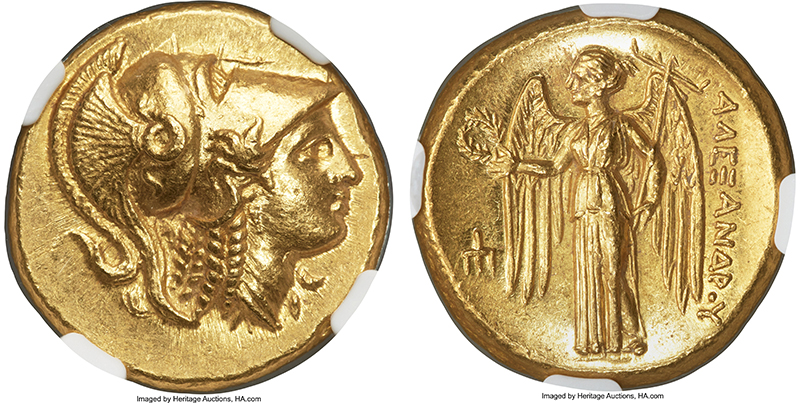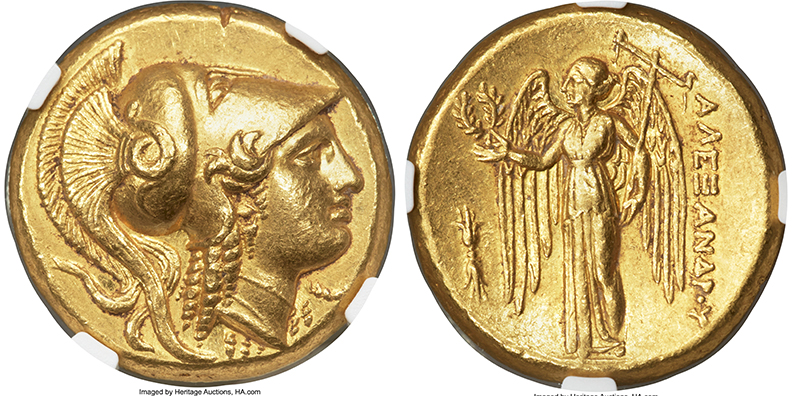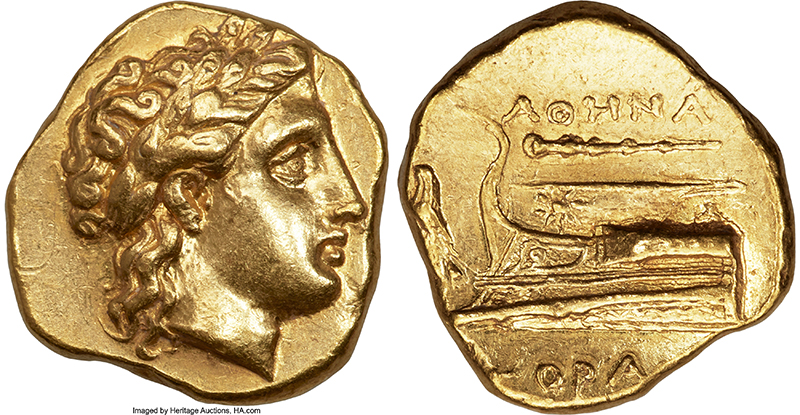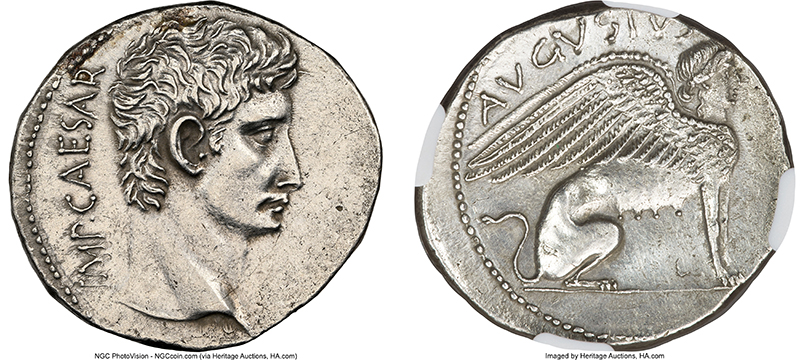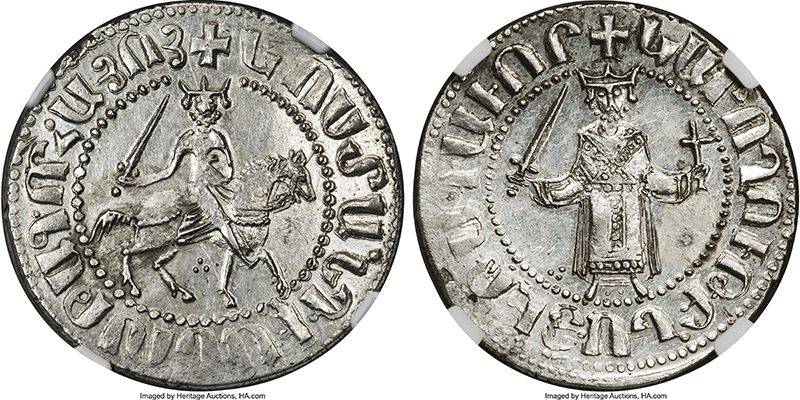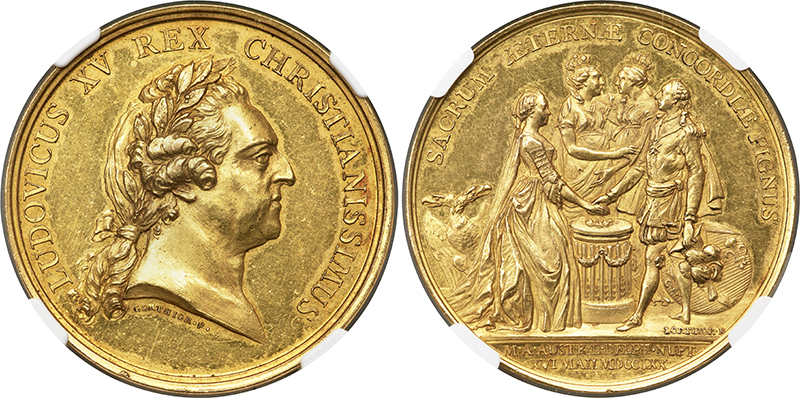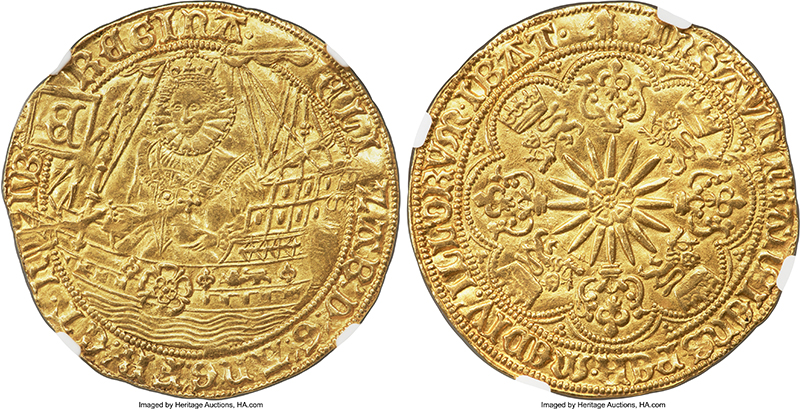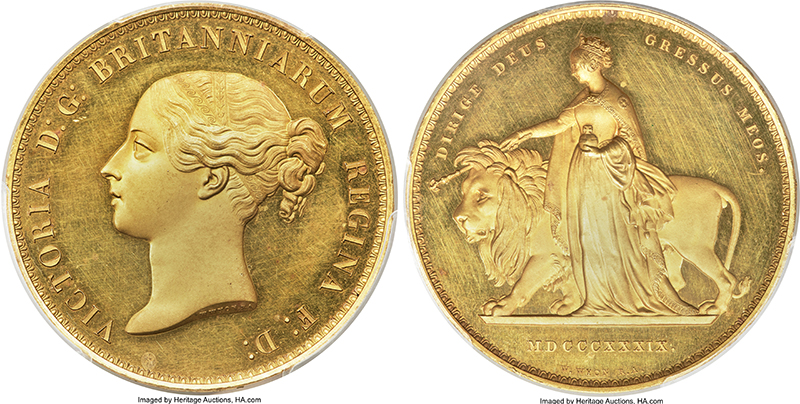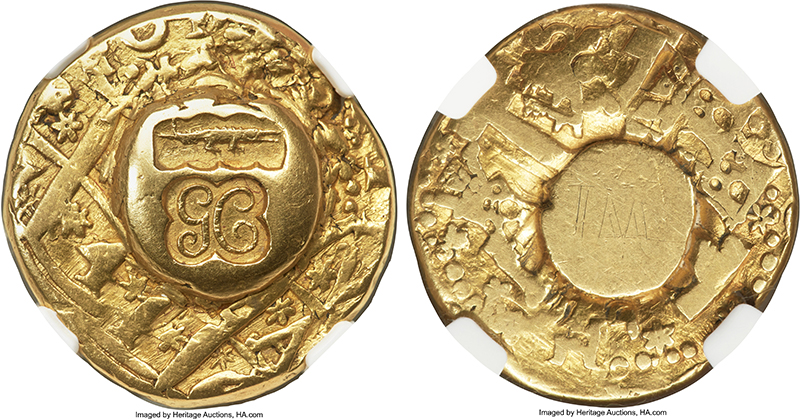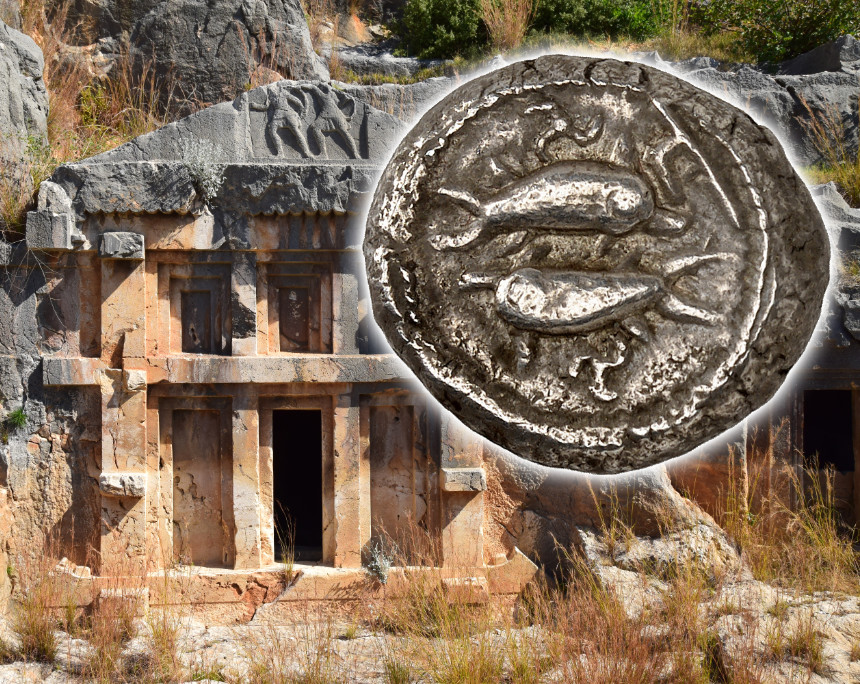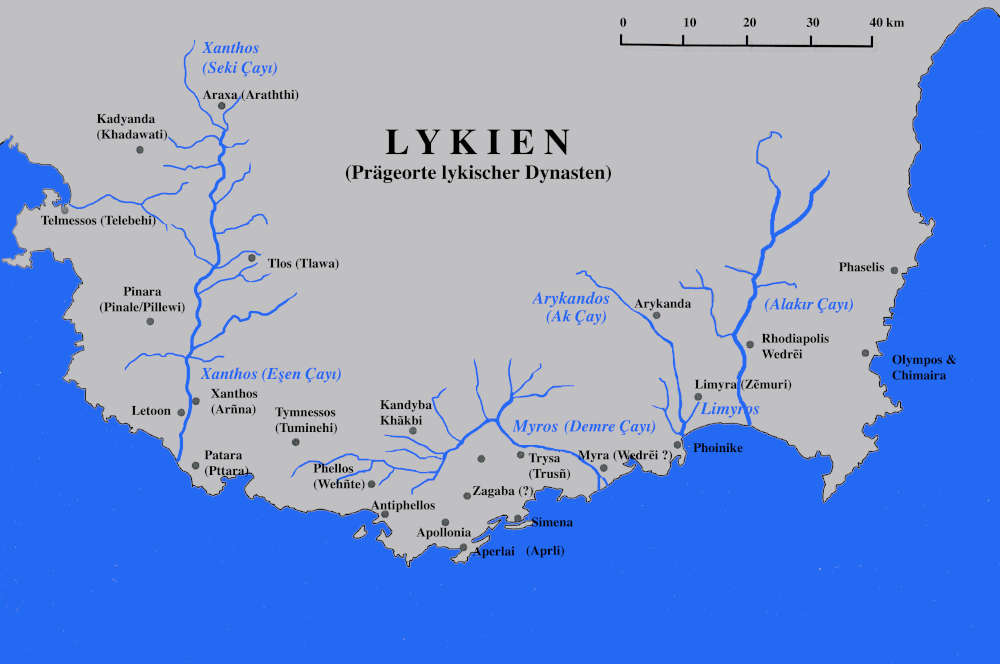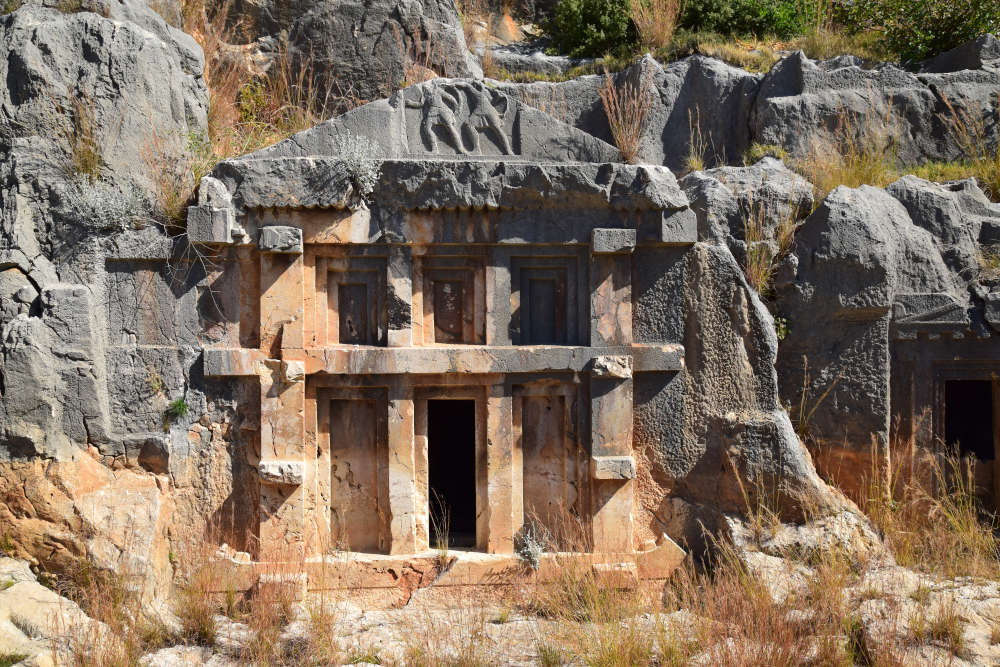The History and Coinage of Lycia
by Johannes Nollé
Lycia is the westernmost and also the most fascinating landscape of southern Asia Minor. It is a peninsula that extends into the eastern Mediterranean and is framed by the Lycian Sea to the west and the Pamphylian Sea to the east.
Content
From the Taurus Mountains, which stretch out from west to east, three mountain ranges rising to over 3000 meters in height protrude southwards into the Lycian Peninsula: the Kragos Mountains (Baba Dağ) in the west, the double-stranded chain of the Massikytos Mountains (Ak Dağlar and Bey Dağları) in the center and the Solymos Mountains (Tahtalı Dağ massif) in the west. These mountain chains are intersected by four river valleys extending in a north-south direction: the largest of these valleys is that of the river Xanthos (Esen Çay) in the west. In the center, the Myros (Demre Çayı) and the Arykandos (Başgöz Çay) cut into the Massikytos massif. To the east flow the Alakir Çay, whose ancient name is still unknown, and the Limyros (Göksu).
From a geographical point of view, Lycia can appropriately be described as the Switzerland of Turkey. Lycia is just as mountainous and equally fragmented into very different, separate regions as Switzerland. The only difference is that it is surrounded by the sea on three sides, which makes Lycia a serious competitor to Switzerland in terms of beauty.
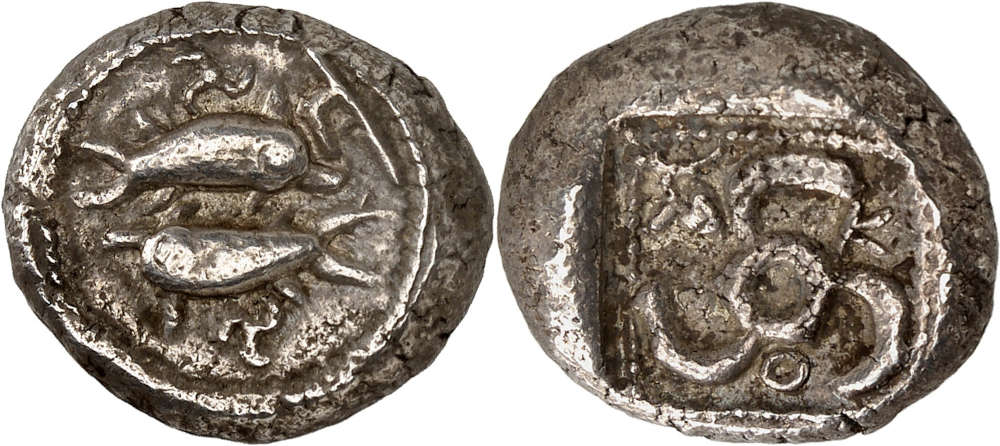
Dynastic issues. Kuprilli. Stater, 470-440, Aperlai / Apollonia or Zagaba. Two dolphins, in the field triskeles and hook. Rev. triskeles and lotus. From the Reuter Collection and the Sayar Collection. Extremely rare. Very fine. Estimate: 750 euros. From Künker auction 402 (14/15 March 2024), No. 66.
A Land of Dynasts
Until 360 BC, when the Persians placed Lycia under the control of the Carian satrap Mausollos, the country was dominated by local rulers (dynasts), who possessed territories of different sizes. The fragmentation of Lycia’s landscape also contributed to the country’s political and administrative division. The dynasts resided in castles, with settlements evolving around them. A few of these were larger than villages and could actually be referred to as towns. To this day, monumental tombs – especially pillar tombs – which have been preserved in many places, as well as inscriptions bear witness to the dynasts’ rule. It is not surprising that the most magnificent dynastic tombs were discovered in the two centers of the dynastic period, in western Xanthos and eastern Limyra.

Pre- and proto-dynastic issues. Stater, 500-480, unidentified mint. A boar’s head to the right. Rev. coarse incusum with two lines crossing each other. From the Hans von Aulock Collection 4054 and the Sayar Collection. Very fine +. Estimate: 300 euros. From Künker auction 402 (14/15 March 2024), No. 10.
Under Persian Rule and Greek Influence
All they required was for the local potentates to pay tribute to them and, if necessary, to provide an armed force. Otherwise, the Persians left Lycia largely to the administration of its autochthonous rulers.
Around 520 BC, the dynasts began to mint their own coins based on Greek models. The influence of Phaselis is likely to have played a role in this. The reverse sides of these earliest Lycian coins were still designed as incusum, while most obverses depicted the front part of a wild boar. When reflecting on the choice of this motif, it should be remembered that wild boars were also a popular motif in Greek coinage. On early coins of Phaselis, the wild boar appears in the form of the prow of a Phaselite ship. In addition, the abundance of wild boars in Lycia meant that this coin design was anchored in the Lycian way of life. As wild boars caused great damage to agriculture by destroying fields and vineyards, the dynasts were forced to organize protective hunts in order to secure the farmers’ yields and thus the taxes they had to pay in kind.
Quite a few Lycian coins are still an enigma to us and defy reliable interpretation. In general, many Lycian coins are objects of puzzling beauty. Nevertheless, alongside many burial texts, they are important historical testimonies to the inner development of this region.
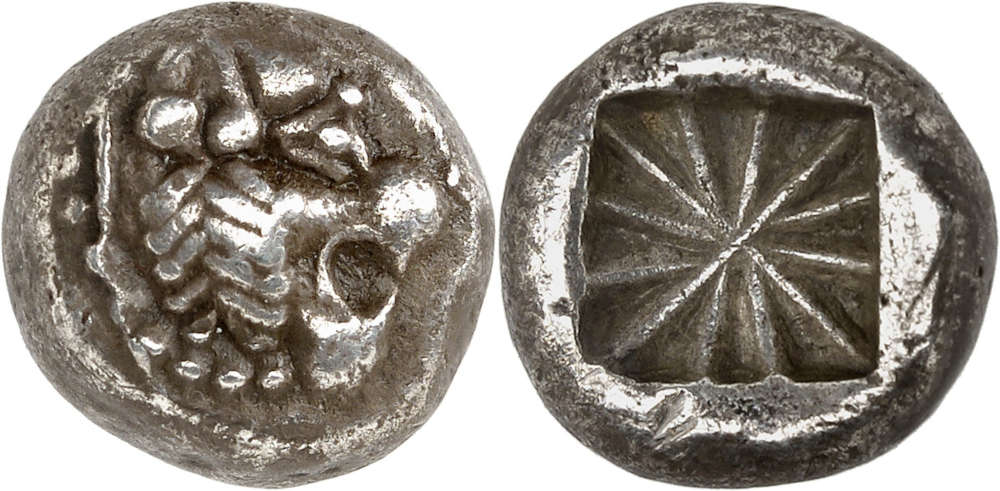
Pre- and proto-dynastic issues. Stater, ca. 500, unidentified mint. Lion’s head to the right. Rev. incusum divided into twelve pieces. From the Hans von Aulock Collection 4041 and the Sayar Collection. Rare. About extremely fine / Extremely fine. Estimate: 500 euros. From Künker auction 402 (14/15 March 2024), No. 1.
The first coins minted by Lycian dynasts were staters according to a Lycian standard. They weighed between 9 and 10 g, usually around 9.5 g. Later, however, a lighter standard also came into use, which might have been modelled on the Attic coin standard: based on this standard, coins weighed between 8 and 8.70 g. These coins show that Lycia’s dynasts did not want Lycia to be a secluded country. On the contrary, they wanted to participate in trade in the eastern Mediterranean and in the progress of civilization. It was not until around 470 BC that smaller denominations of the stater were minted to be used in everyday life. Monetary transactions were boosted by the introduction of bronze coins around 400 BC.
Lycian coinage reveals a certain prosperity of the country, which can be seen to this day in the magnificent tombs of the Lycians. Their wealth was probably based primarily on agricultural production and timber harvesting.
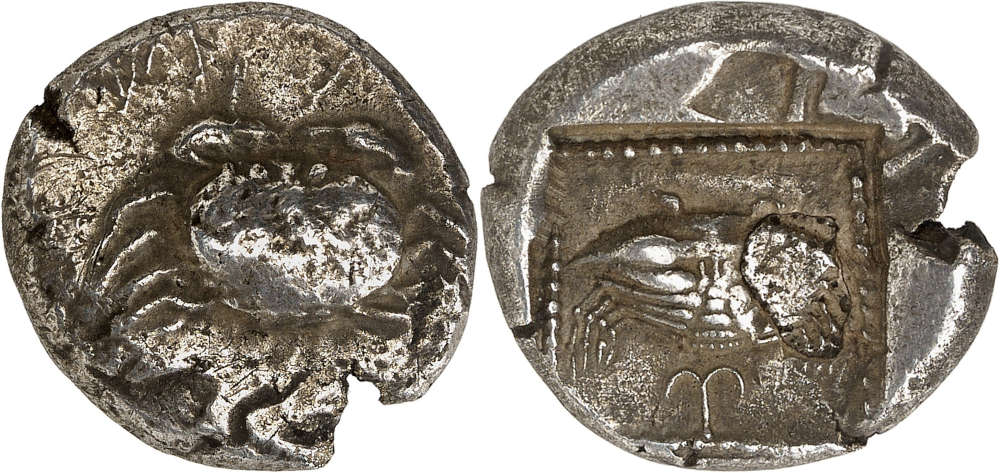
Pre- and proto-dynastic coinage. Amartite. Stater, ca. 480, unidentified mint. Crustacean. Rev. pearl square, in it a crustacean. From the Tronnier Collection and the Sayar Collection. Very rare. Estimate: 400 euros. From Künker auction 402 (14/15 March 2024), No. 39.
Around 480, the incusum on the coins gave way to reverse images. On the obverse, the wild boar theme still occupied a large space; however, other animal images gradually appeared, some of which were based on Greek coin designs.

Dynastic coinage. Kuprilli. Stater, 470-440, Aperlai / Apollonia or Zagaba. Dolphin to the right above stylized waves. Rev. pearl square, in it a triskeles with a griffin’s head. From the Reuter Collection and the Sayar Collection. Very rare. Very fine. Estimate: 750 euros. From Künker auction 402 (14/15 March 2024), No. 70.
The triskeles or tripod, on rarer occasions also a quadruped/tetraskeles, were symbols of fast rotation, i.e. tremendous speed, and could be associated with many rapid processes, such as the course of the sun during the year. People in antiquity were also fascinated by speed, and their imagination found ways to express what must almost be referred to as an exhilaration of speed. This is why many animals on Lycian coins have wings: there are winged wild boars, lions, horses, bulls and stags. By adding wings, animals that were already fast by nature were transformed into mythical creatures, and often into monsters as well.
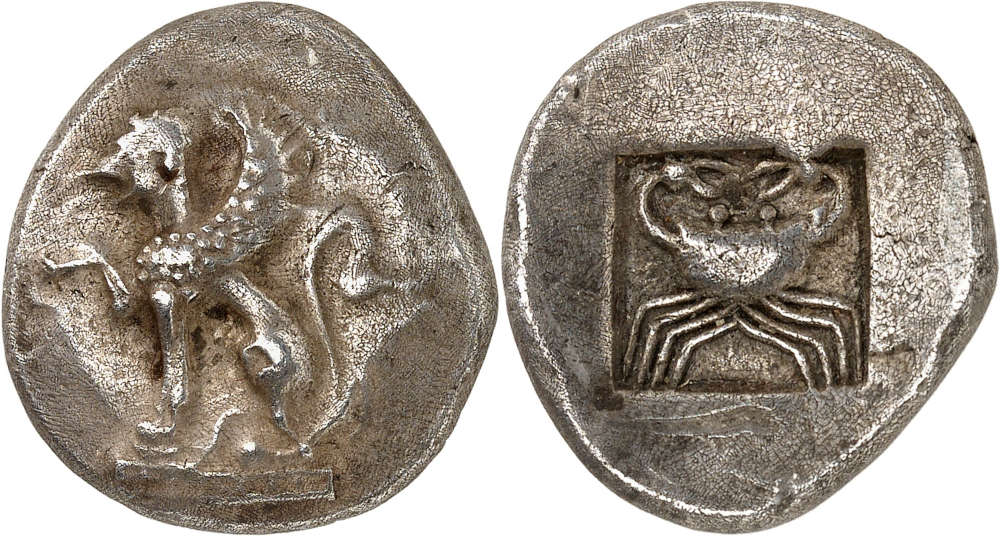
Pre- or protodynastic coinage. Unknown dynast, perhaps Amartite. Stater, 480-460, unidentified mint. Sphinx to the left. Rev. crustacean. From the Sayar Collection. Very rare. Very fine. Estimate: 1,250 euros. From Künker auction 402 (14/15 March 2024), No. 41.
In some cases, such depictions may have been based on oriental models. This also applies to the sphinx, which appears on Lycian coins. Gradually, deities were also depicted on coins. They appear in Greek iconography and, despite their Greek imagery, were probably associated with Lycian concepts of gods.
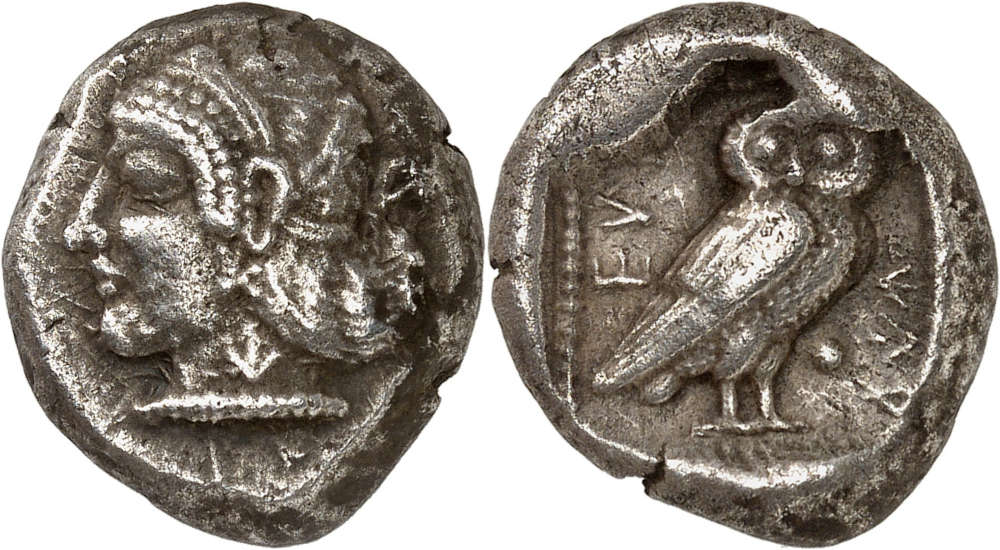
Dynastic issues. Kheriga. Stater, 440-430, Phellus. Female head to the left, perhaps Aphrodite. Rev. little owl to the right. From the Sayar Collection. Very rare. Very fine. Estimate: 2,000 euros. From Künker auction 402 (14/15 March 2024), No. 140.
Of particular significance is the monetary depiction of Athena and her owl, as it testifies to the growing influence of the Athenians on Lycia (cf. Vismara 1996, 143-161: Tipologia; Müseler 2016, 10-27: Bildprogramme und deren geographische Zuordnung).
From 450 BC onwards, more and more legends in Lycian script and language can be found on coins. They show how Lycian rulers insisted on their own culture. However, over 35% of the Lycian coins known to us do not have legends, which is why we can assume that even after the emergence of coins with legends, some mints continued to issue money without them. The legends refer to the mint master and/or the place of minting – often in an abbreviated form. Occasionally, particularly powerful dynasts were referred to as khñtawati, i.e. a man who stands at the top, a ‹prince›. We know the name of around 60-70 dynasts that minted Lycian coins.
Between Persian and Athentian Dominion
When the dynasts of Xanthos/Arñna in western Lycia and later the dynasts of Zêmuri in eastern Lycia endeavored to extend their rule over neighboring dynasts and their territories – if not over the whole of Lycia – this resulted in never-ending war. The dynasts of Xanthos attempted to gain the consent or even the support of the Persians in order to achieve far-reaching hegemony, especially in western Lycia. Following Persia’s failed attempt at conquering Greece, the Persians suffered a period of weakness. Combined with the fact that the Athenians and the naval league dominated by them made increasing inroads into the eastern Mediterranean around the middle of the 5th century BC, this resulted in the Xanthian dynast Kuprlli (ca. 480-440 BC) attempting to do business with the Athenians. Under the dynast Kheriga, the Xanthian dynasty – probably due to bad experiences with the Athenian League and its outrageous tribute demands – turned back to the Persians, who were grateful for this development and thus allowed, if not encouraged, the expansionist desires of the Xanthian dynasty.
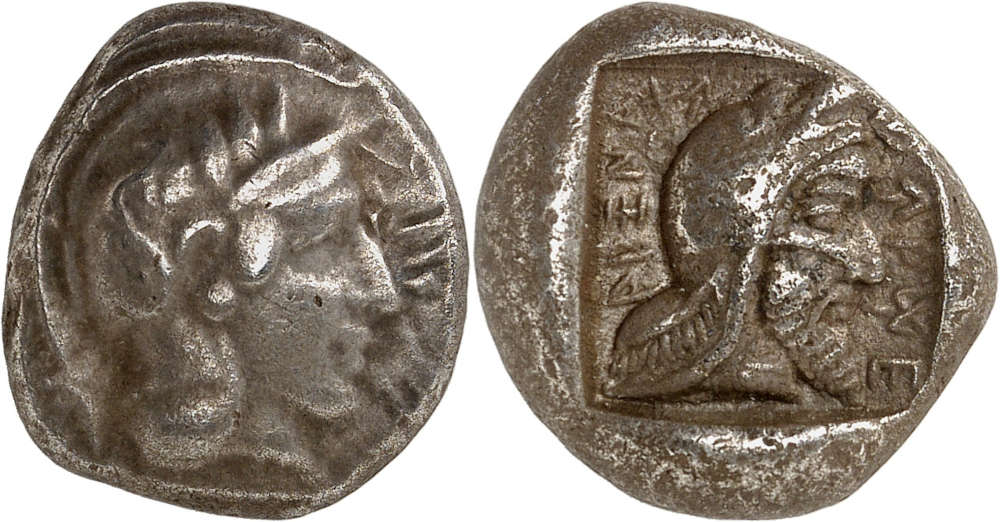
Dynastic issue. Kherei. Stater, 430-410, Xanthos. Head of Athena to the right. Rev. head to the right with Kyrbasia. From the Sayar Collection. Rare. Very fine / Very fine +. Estimate: 500 euros. From Künker auction 402 (14/15 March 2024), No. 155.
During this period, ‘portraits’ – initially without distinctive physiognomic features – appeared on Lycian coins; however, accompanying legends helped to clearly identify the person depicted. The dynasts represented on the coins often wore Persian garments such as the Persian tiara (‘Başlık’), demonstrating their loyalty to the Great King and the honor they had received in return. These Lycian coins play an important role in the development of coin portraits, which initially could not emerge in the Greek poleis, as coin images were reserved for gods. Depicting living people, however meritorious and important they may be, would have been perceived as crossing a line.
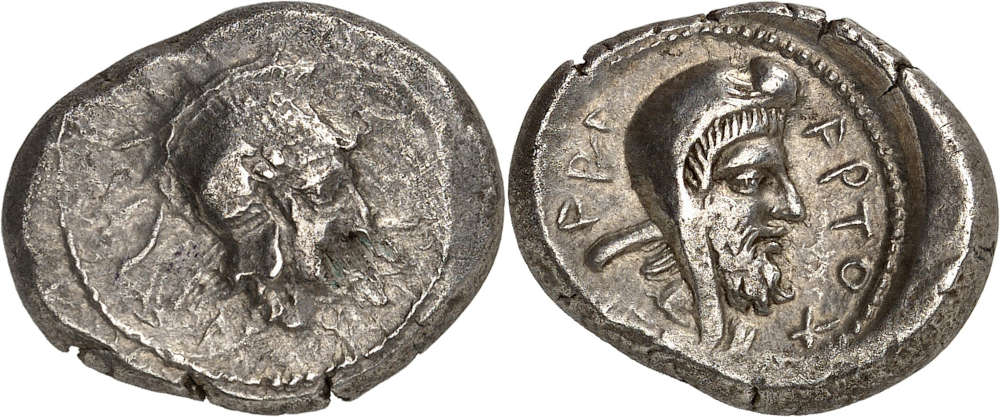
Dynastic issue. Artumpara. Stater, around 370, unidentified mint (Xanthos?). Head of Athena to the right. Rev. head with Kyrbasia to the right. From the Sayar Collection. Extremely rare. Very fine. Estimate: 1,500 euros. From Künker auction 402 (14/15 March 2024), No. 247.
Pericles’ Fate
While the Xanthian dynasty had tried to take control of the whole of Lycia from the west of the territory, Pericles of Limyra endeavored the same from the east of Lycia between 380 and 360 BC – at first together with Trbbênimi, later as a sole ruler. His Greek name, whom the famous Athenian statesman was inevitably associated with, could be understood as Pericles’ willingness to put all eggs in the Greek basket. Persia, however, was not prepared to accept Pericles’ efforts to take over supremacy in Lycia from the Xanthian dynasty. After all, the Xanthians were in decline but still closely aligned with the Persians.
When the Xanthians became increasingly caught up in family disputes after the death of Erbbina and lost their power, the Persians sent Mithrapata und Artumpara to Lycia to secure their rule and put Pericles in his place. This caused Pericles to break ties with the Persians. He succeeded in defeating Artumpara, who apparently fled to Side, from where he set up armor against Pericles. Pericles was even able to conquer Telmessos in far-away western Lycia. Pericles’ success appears to have contributed to some satraps turning against the Persian Great King.
The Downfall of Dynasts
Family disputes within the Xanthian dynasty, Persia’s growing mistrust of Xanthian power and the conflict between the Xanthians and Pericle of Limyra, who had risen to greater power in eastern Lycia, ultimately led to the downfall of Lycian dynastic rule. When Pericle not only threatened the Xanthian dynasts’ rule over western Lycia, but also challenged Persian suzerainty over Lycia, the Persian satrap Autophradates intervened and took violent action against the insubordinate Lycians. Eventually, Lycia was placed under the rule of the Karian and Persian satrap Mausollos around 360 BC. This put a definite end to Lycian dynastic coinage.
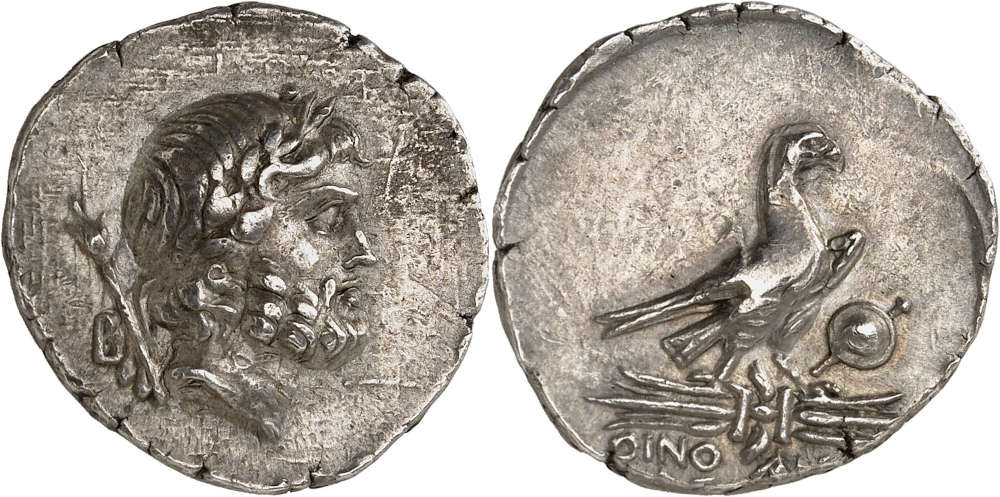
Oinoanda (Lycia). Stater, early 2nd century. Head of Zeus to the right. Rev. eagle on a lightning bolt. From the Sayar Collection. About extremely fine. Estimate: 600 euros. From Künker auction 402 (14/15 March 2024), No. 284.
Greek Poleis in Lycia
The elimination of Lycian dynasts and the destruction of the Persian Empire by Alexander the Great almost 30 years later led to the gradual establishment of the Greek polis system in Lycia and the emergence of cities, whose structure followed the Greek model. However, Lycia did not remain free of overlords. From 309 to 197 BC, the country was ruled by the Egyptian Ptolemies. Antiochus the Great conquered Lycia in 197 BC, but his rule was only an interlude. When the Romans defeated him at the Battle of Magnesia at Sipylos in 190 BC, he was forced to cede Lycia to the Romans’ ally Rhodes. However, the new rulers were highly unpopular with the Lycian population and Lycian cities began to unite in resistance against Rhodes.
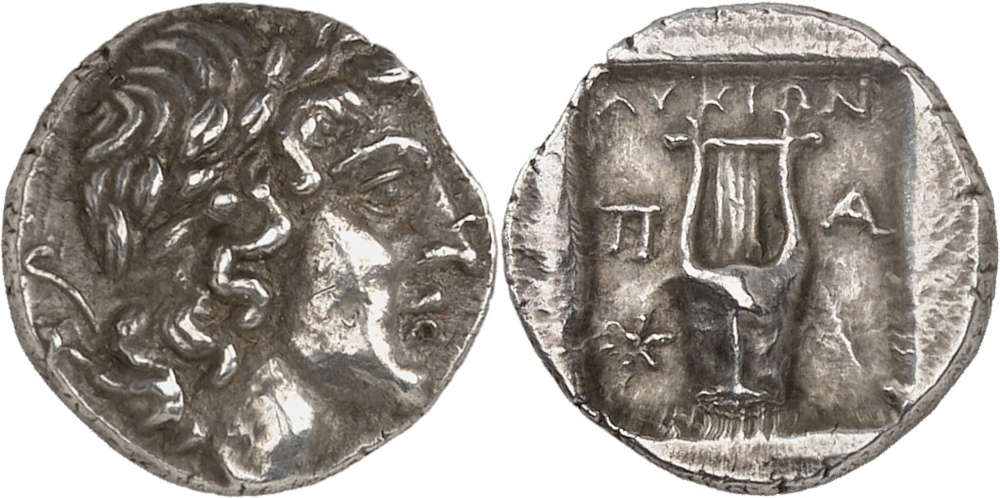
Lycian League. Patara. Drachm, 167-81. Head of Apollo to the right. Rev. Lyra, 1st star. From the Sayar Collection. Extremely fine / Very fine. Estimate: 750 euros. From Künker auction 402 (14/15 March 2024), No. 299.
Since Rhodes had become increasingly powerful, with Rhodian merchants standing in the way of the economic interests of Roman merchants, Rome took advantage of the conflicts in Lycia to declare Lycia free in 167 BC (Behrwald 2000, 105 ff.). At that time, the Lycian League was formed to protect the country from foreign domination and to maintain peace at home. After a period of more than one and a half centuries during which Lycians had not minted their own coins, they now began to produce federal coins. These pieces were modelled after Rhodian plinthophores, but bore the head of Apollo on the obverse and Apollo’s kithara in a rectangular recessed area (gr. plinthos) on the reverse, flanked by legends that identified the Lycians, the regions of Kragos and Masikytos and, for a shorter period, Phaselis and Olympos as minting authorities (Troxell 1982; Behrwald 2000, 107). When Lycia became a Roman province in AD 43, the Lycian League was transformed into a provincial council, which was primarily responsible for the imperial cult and the support of the Roman administration. Under Gordian III, Lycian cities minted their own coins for the last time.
The first part of the coins of the Sayar Collection will be auctioned off by Künker on 14 and 15 March 2024 in Osnabrück. The focal point is on issues from Lycia, but also from Pamphylia and Cilicia. Johannes Nollé did not only author this text but also a brochure with the title “Dr. Ing. Kaya Sayar and his magnificent Asia Minor collection“.







